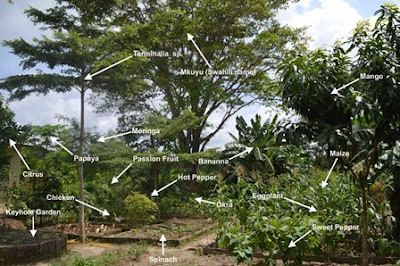PDC LESSON 4.1 SOIL – FOOD GROWS WITH CHEMICAL
PERMACULTURE COURSE AGRO-ECONOMY
PDC LESSON
4.1 SOIL – FOOD GROWS WITH CHEMICAL
Foods grown with
chemicals
have different
nutritional readings. They are not as mineral rich as our organic counterparts.
This is because of some very basic differences in the way these plants are
grown. All plants have two sets of roots. The thin white roots are the feeder roots,
and the older darker roots are the roots that take up the moisture from the
soil. As you see both sets have different functions. Plants like humans cannot
feed directly of the minerals from the soil.
The plants’ mineral needs come from the cation/anion interchange for the
minerals to become available to the
feeder roots. This very complex set of circumstances is provided in the humus
part of the soil and all the life forms associated with it.
Growing plants
without the natural complexity of soil life, but rather by using chemical
fertilisers, is to force feed them.
This is done
by applying chemical fertilisers that have the minerals available in water soluble
form. The water roots are then forced to take up whatever the farmer applies to
the soil and the plant is then force- fed with the fertiliser. The overuse of
urea to add nitrogen to the soil is a very real problem to our health. Vegetables that give off a lot of water are a symptom
of being force fed by too much nitrogen. Large crisp looking cabbages and
enormous lettuces that are chemically grown are full of nitrates that form into
nitrites and contribute to ill health, and in the long run cancer. The entire
metabolism of these plants is interfered with as they are giants composed of
mainly salts and water.
Peeling
chemically grown potatoes is a messy business against the splashboard in my
kitchen; it always needs a vigorous wipe down after peeling them. This does not
happen when I peel my own home- grown potatoes.
Text from the roots, Elisabeth Ferkonia (Aus.) PDC
studied with Bill Mollison,



Comments
Post a Comment